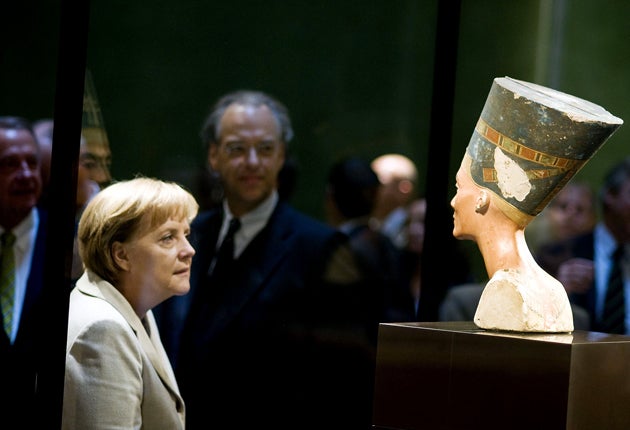Queen Nefertiti rules again in Berlin's reborn museum
Seventy years after it was destroyed by war, Neues's reopening hailed as miracle

Your support helps us to tell the story
From reproductive rights to climate change to Big Tech, The Independent is on the ground when the story is developing. Whether it's investigating the financials of Elon Musk's pro-Trump PAC or producing our latest documentary, 'The A Word', which shines a light on the American women fighting for reproductive rights, we know how important it is to parse out the facts from the messaging.
At such a critical moment in US history, we need reporters on the ground. Your donation allows us to keep sending journalists to speak to both sides of the story.
The Independent is trusted by Americans across the entire political spectrum. And unlike many other quality news outlets, we choose not to lock Americans out of our reporting and analysis with paywalls. We believe quality journalism should be available to everyone, paid for by those who can afford it.
Your support makes all the difference.For sixty-six years, much of the historic Neues Museum, Berlin's equivalent to the Louvre, was a bombed-out ruin in the heart of the city. Today it will reopen for visitors with a bust of the Egyptian queen Nefertiti taking pride of place, after a €212m (£193m) restoration masterminded by leading British architect David Chipperfield.
The museum was officially reinaugurated yesterday by Germany's Chancellor Angela Merkel, who lives opposite the cultural complex in the city's revamped centre. The renaissance of the museum, which contains 9,000 exhibits and artefacts ranging from a 700,000-year-old Stone Age shaped flint to a piece of barbed wire taken from the Berlin Wall, marks the return of one of Germany's most important cultural landmarks to the reunited city.
The event was described as a second miracle for Berlin after the fall of the dividing wall two decades ago. Michael Eissenhauer, general director of the city's museums, said the occasion was thrilling. "There is a wonderful electrifying power here," he said. "I won't ever experience a moment like this again in my life." Pride of place is occupied by the 3,400-year-old bust of Queen Nefertiti, the Neues Museum's star exhibit, which has been reinstalled in its former resting place after spending the last days of the Second World War in a German salt mine and 29 years in a museum in the old West Berlin. Other exhibits include a ceremonial golden Bronze Age "wizard's hat" more than 2ft tall, dating from 1,000 BC.
The reopening of the museum also signified the final stage in the restoration of the 19th-century city centre "Museum Island" complex commissioned by the Prussian kaisers, after an interval lasting 70 years. "It is like the missing pearl being finally added to a necklace," said Hermann Parzinger, president of Germany's Prussian Cultural Foundation.
The complex was closed to the public in the autumn of 1939 and badly bombed during the Second World War. The Neues Museum suffered several hits during a Royal Air Force raid in 1943. Invading Red Army troops further damaged the building and plundered one of its most priceless exhibits, King Priam's treasure, the collection found by the German archaeologist Heinrich Schliemann. That was taken to Moscow where it is still housed in the city's Pushkin Museum. East Germany was unable to pay for repairs to the museum after the war.
As part of the restoration concept, Chipperfield chose to leave many of the wartime scars inflicted on the building untouched. In the main entrance, originally constructed in 1855 to a design by the German architect Friedrich August Stüler, the walls remain stripped back to bare brick. Inside, Chipperfield has installed an elegant modern staircase of white cement and marble.
He admitted that restoring a war ruin was a task unlike anything he had done before. "We felt very strongly that we should hold on to the original material," he said, "but that was a very difficult thing to describe to the public and there was a lot of emotional anxiety about what this would mean in the end." Despite harsh criticism from some interest groups, the restoration has been widely praised.
Join our commenting forum
Join thought-provoking conversations, follow other Independent readers and see their replies
Comments